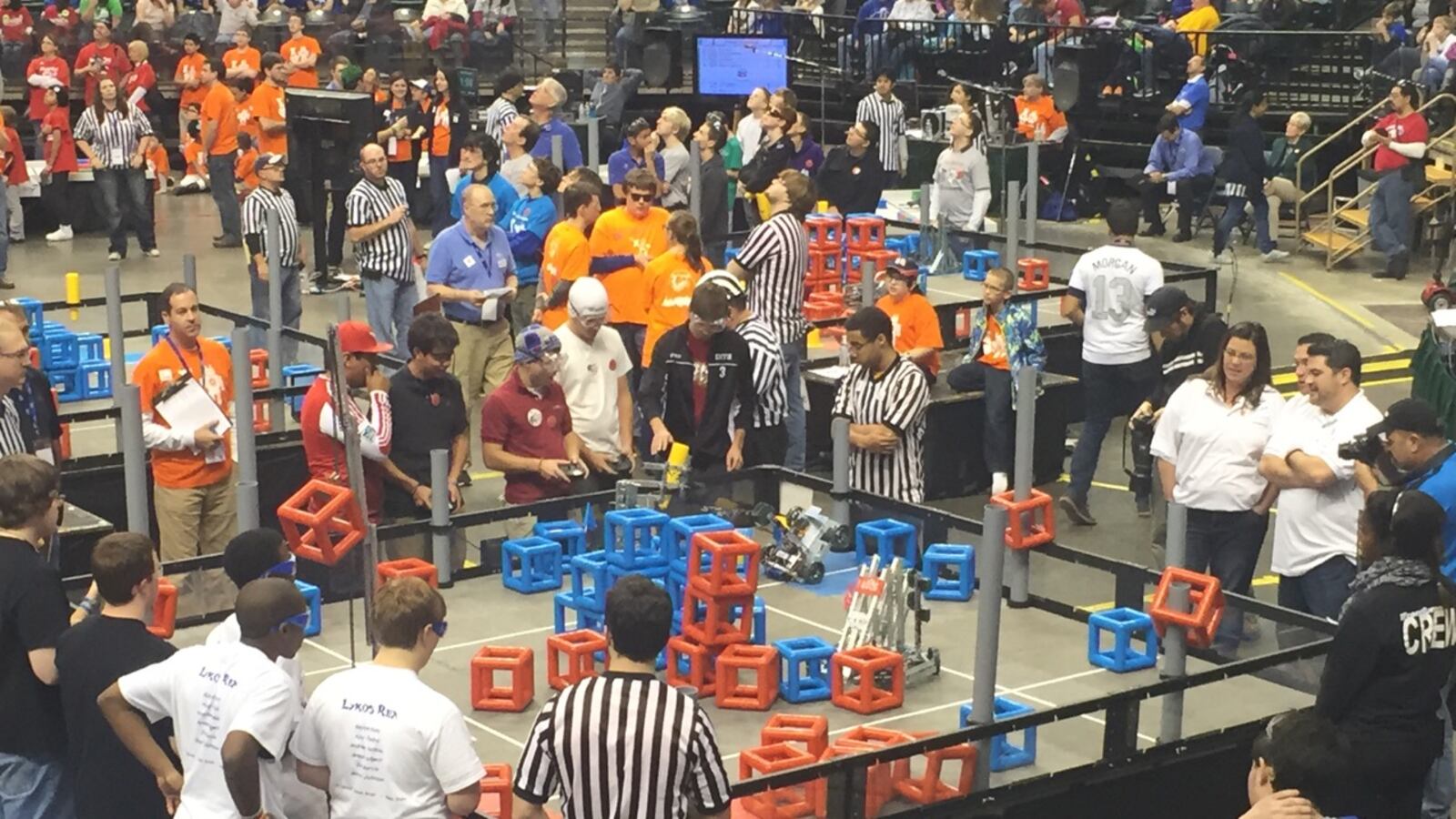Things looked grim for the Providence Cristo Rey High School robotics team at the start of practice on Thursday night. It had a little more than one day to ready for the city’s robotics championship and the kids were rebuilding their robot when they should have been refining their strategy.
“Thursday at 10 p.m. we had a robot that couldn’t lift its arm,” coach and teacher Jon Osborn said. “There were some desperate actions.”
But that’s the idea behind the city-wide competition — get smart kids working together to solve problems so they can keep competing. The contest is a new idea in Indianapolis: just the third year of the competition wrapped up Sunday after 114 high school, middle school and elementary school teams competed.
Overall, Speedway won the top award for an individual team, earning a spot in the world championships in April. Franklin Township Middle School was the top middle school team, advancing to the state tournament. Warren Township’s Stonybrook Intermediate Academy won the new elementary school division.
But the biggest showdown of all was the one Cristo Rey was angling for all weekend: the team tournament championship.
Building a robotics team
Cristo Rey, a small Catholic high school with a unique work-study program, could not have gotten its start in robotics without a little help because building robots is expensive. Fortunately for the team, first and second year entrants can have their $100 entry fees waived by the city and receive a free kit to build one robot. In year two, teams get some supplementary parts added to their kit. By the third year, schools must support the costs themselves.
Cristo Rey’s coach, Anna Sluka, is a chemistry and physics teacher who coached robotics for 11 years in other schools starting when her own children competed.
“All three were in (robotics) from third grade on and took two or more programming classes in high school,” Sluka said of her kids. “They found that to be a piece of cake since they’d been doing it for so long.”
Giving her students exposure to science, technology, engineering and math fields in a fun way that isn’t tied directly to academics could be the first step toward rewarding and lucrative careers, she said.
At Cristo Rey, college and future jobs are a focus. All of the roughly 200 students are assigned work-study jobs that pay most of the $12,000 annual tuition, which is routed directly to the school. More than 60 company partners, including many of city’s most high-profile corporate brands, employ its students.
The Cristo Rey network began as a new Catholic school concept in Chicago and has now spread to 28 schools in 27 cities. The schools are aimed at providing opportunity for poor families. Middle class families generally make too much income to qualify. As a result, Cristo Rey has a similar demographic makeup to many public high schools: Almost 83 percent of its students are poor enough to qualify for free or reduced-price lunch and about 89 percent of students are black, Hispanic or biracial. But since its first Indianapolis graduating class in 2011, all 75 of its seniors have graduated and were accepted to college.
The students might be experienced with working at jobs, but creating a robot that can compete is time consuming. The team meets every week for about four hours, and even more often before a competition. It can be hard for kids to balance that with homework and jobs, Sluka said, but the six students on her team are managing.
Only two are returning members, but despite their novice status, the team did well at last year’s city competition. They were part of a group of teams that were tournament champions and also took home a prize.
“We were hoping not to finish last,” Sluka said. “We were a first-year team who started in the middle of September with totally novice kids, and we won the championship.”
Robots teach science and math skills
It was Mayor Greg Ballard who sought to bring a citywide robotics challenge to Indianapolis after he was impressed by the ingenuity and student effort at a smaller robot competition he visited at Southport High School.
The VEX Robotics Competition, a worldwide contest, is a fast-growing hit with local schools, growing from 38 high school teams in Indianapolis in 2012 to more than 114 elementary, middle and high school teams this year. The competition aims to elevate student work in science, technology, engineering and math to a level of excitement and competition much like team sports.
Organizers said the kids, especially those from less affluent schools, are learning skills they might not otherwise get in an activity they think of as fun rather than work.
“Robotics can spark interest at an early age — think of it like a real-life video game,” said Stephanie Bothun, director of education initiatives with the mayor’s office. “Students build and create a robot to do something, and it actually does those things.”
Each year, VEX releases a new challenge that the robots must compete in. This year, the tournament challenge was set in a 12-foot by 12-foot square field, with goalposts of varying heights around the perimeter of the field. In the middle were stacks of hollow cubes that the robots could either lift to stack on the goalposts or assemble into towers using round pieces that fit together to form the tower’s structure.
Two robots make up each team — blue or red — and the teams must outscore their opponents by stacking more cubes on goalposts or building taller towers. A robot must either stack cubes on goalposts, be able to build towers or both.
Choosing a winning strategy
Cristo Rey decided to have its robot focus on doing one task well rather than attempt to do both: stacking the cubes. Earlier in the week the robot’s accordion-style folding arm and pincer-like claw, which sat on a hexagonal base with four wheels, was too heavy to support, breaking gears on the base.
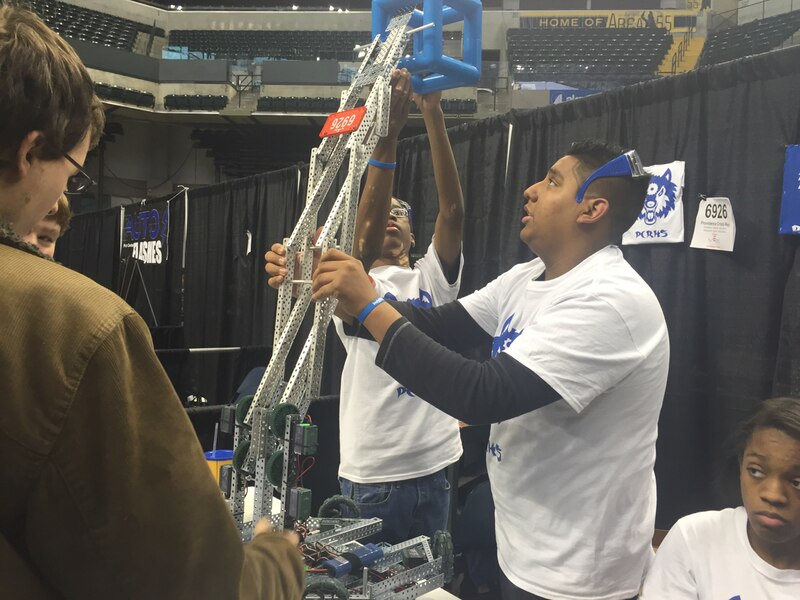
Team members spent hours taking apart and rebuilding it, but they didn’t have the time to perfect the design. The claw came off and pieces were added to the base for stability. The robot could stack without the claw, but it couldn’t build towers. The code they’d written to open and close the claw was suddenly useless.
Each team, which can have up to 10 members, is usually split up so groups of students specialize in one or two tasks. Two juniors on Cristo Rey’s team, Andrew Watkins and Kaylyn Hicks, are returning members who specialize in programming the robot. Junior Ajay Pandya, sophomore Armon Badgett and freshmen Jose Garcia and Garrett Johnson focused on physically building the robot and driving it with joysticks in the competition.
“The kids self-select the roles and pick which ones they like,” Sluka said. “They take ownership over different areas, but they have to be able to swap out to make up for if people are missing.”
Sluka said kids join the team who’ve never had robotics or engineering experience. The coaches get them started and help them learn to use the tools and materials, but the work of designing the robot is theirs.
Once the kids get the parameters of the challenge, they go through a long design period to figure out the best kind of robot to build. Sluka and her fellow coaches will question and guide the team, asking the students to explain their thinking for a particular design choice or encouraging them to experiment, but it’s largely hands off.
Hicks said she plans to use her coding experience on the robotics team to help her major in software development when she goes to college. She joined the team for her love of math and science, but mostly it was about trying something new. It helped her discover she liked programming.
“Even way before high school I knew I wanted to do science,” Hicks says. “I just didn’t know what kind. Then I found robotics … you never know if you like it until you try it.”
The final showdown
The robot is the focus of all the preparation before the competition, but once there, students have to step away from the technology to advance into the upper levels of the tournament.
After preliminary rounds, the top eight teams are eligible to pick two other teams to form groups to compete together in quarterfinals. Those eight teams can choose any of the 49 high school teams for their group, so during competition Cristo Rey’s team talked up its strengths and demonstrated good teamwork.
They did it effectively, coach Elaine Grant said. Throughout the day students focused on cooperating with the other teams and just generally being friendly. By building a robot that did one important aspect of the challenge well, the team also showed it would be an asset as a partner.
Those choices paid off.
Although Cristo Rey ranked 20th in the preliminary competition, the team was picked to compete with the top-ranked team from Chatard High School and the eighth-ranked team from Irvington Community School.
As the Cristo Rey team and its supporters cheered and hugged at their selection, coach Jon Osborn said with laugh: “Now we’ve got to not screw up.”
The 1.5-minute quarterfinal rounds zoomed by, and PCRHS’s alliance easily moved into the semifinals, and then, the finals. It was down to two alliances of three teams each — PCRHS, Chatard and Irvington for the red team against students from Lawrence Township’s career-focused high school the McKenzie Center, Heritage Christian High School and Franklin Central High School, last year’s top prizewinner, on the blue team.
The first of three final rounds started, and soon the whole arena was on its feet. Red won the first round by stacking enough cubes on the goalposts to cancel out any points the blue team got for building towers.
The start of the second final round had everyone a little nervous — The blue side had stellar performance in previous rounds building towers taller than any other team achieved during the whole competition.
Then as Cristo Rey’s group began again, a series of small mishaps seemed to sap the kids and their coaches of their remaining energy: the Cristo Rey’s robot dropped a couple cubes, costing valuable points. The robot’s arm shook as it attempted to stack the cubes, betraying the unsteadiness of its driver.
“They’re nervous now,” Grant said, watching from the stands and trying to will a steadier robot arm with good wishes. “It’s alright. Take it easy.”
The blue team took the second round with a high-scoring tower, leaving just one more 90-second round with a chance for one team to break the tie.
The robots worked haphazardly to gather cubes and try to place them onto goalposts or drop them precariously over towers of yellow cylinders. But this round wasn’t a shutout like previous rounds. Each team managed a respectable number of point-scoring structures, and it wasn’t immediately clear who the winner was, leading the organizers to take extra care when tallying the points.
Sluka and Grant turned around in the stands, not quite able to look at the screen when the results were ready. A few seconds later, the stands erupted. The red team — the alliance that included Cristo Rey — beat the blue team, 41 to 26.
List ViewSwitch to list view
SlideshowSwitch to slideshow view
ReplayBack to Beginning
back1 of 3next
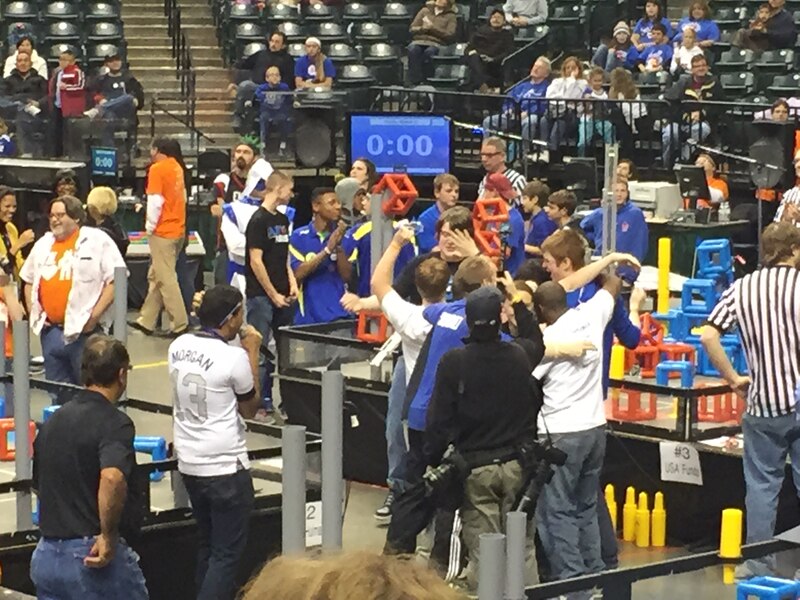
Start Slideshow

- PHOTO: Shaina CavazosThe Providence Cristo Rey High School robotics team and its partners during the competition Sunday cheer when they learn they’ve won the tournament.
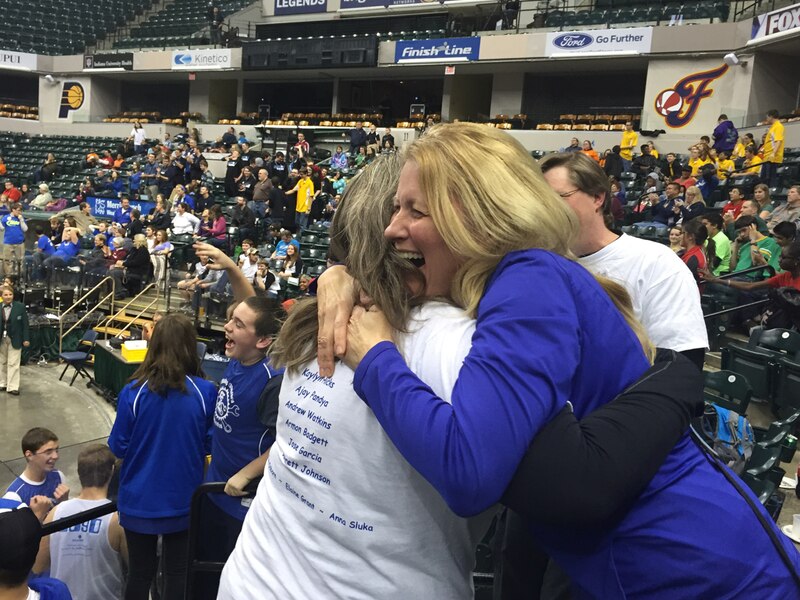
- PHOTO: Shaina CavazosProvidence Cristo Rey High School robotics teams coaches Anna Sluka (left) and Elaine Grant (right) hug when their team is announced as a winner.
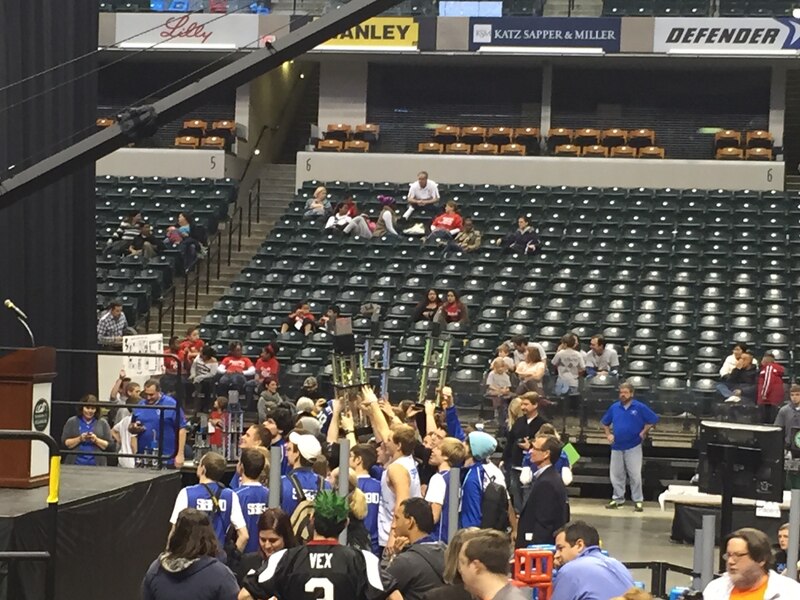
- PHOTO: Shaina CavazosWinning teams in the VEX robotics competition tournament celebrate Sunday.

PHOTO: Shaina CavazosThe Providence Cristo Rey High School robotics team and its partners during the competition Sunday cheer when they learn they’ve won the tournament.

PHOTO: Shaina CavazosProvidence Cristo Rey High School robotics teams coaches Anna Sluka (left) and Elaine Grant (right) hug when their team is announced as a winner.

PHOTO: Shaina CavazosWinning teams in the VEX robotics competition tournament celebrate Sunday.

PHOTO: Shaina CavazosThe Providence Cristo Rey High School robotics team and its partners during the competition Sunday cheer when they learn they’ve won the tournament.

PHOTO: Shaina CavazosProvidence Cristo Rey High School robotics teams coaches Anna Sluka (left) and Elaine Grant (right) hug when their team is announced as a winner.

PHOTO: Shaina CavazosWinning teams in the VEX robotics competition tournament celebrate Sunday.
For the second time in as many years, Cristo Rey’s robotics team was part of an alliance that won the championship. As winners, the team received another robot kit to supplement their materials, and two of their team members will have a chance to do a paid internship at the city’s Information Services Agency.
That the team had such serious setbacks earlier in the week seemed almost laughable — two wins in two years was beyond any of the coaches expectations.
How can they top this next year? To Sluka, it’s about getting more kids involved.
“I want a second team,” she said.

